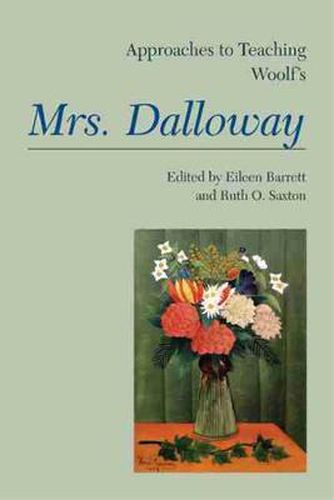Readings Newsletter
Become a Readings Member to make your shopping experience even easier.
Sign in or sign up for free!
You’re not far away from qualifying for FREE standard shipping within Australia
You’ve qualified for FREE standard shipping within Australia
The cart is loading…






Mrs. Dalloway is considered a central work in Virginia Woolf’s oeuvre and in the modernist canon. It not only addresses historical and cultural issues such as war, colonialism, class, politics, marriage, sexuality, and psychology but also reimagines the novel form. Moreover, Mrs. Dalloway continues to grow in its influence and visibility, inspiring adaptations in film, theater, print, and other media.
Despite Mrs. Dalloway’s continued popularity, many students today find the prose daunting and a barrier to their appreciation and comprehension of the novel. This volume seeks to give instructors a variety of strategies for making Woolf’s work compelling and accessible to students while addressing the diverse ways it has been interpreted. Part 1, Materials, reviews editions of Mrs. Dalloway as well as critical and historical resources related to the novel. Part 2, Approaches, explores the task of contextualizing this key modernist text in the classroom. Some contributors situate Mrs. Dalloway in its historical time and place, namely, London in the period between the two world wars. Others discuss the novel’s narrative form or interpret it using perspectives from cultural studies, feminism, or queer theory. Still others address the novel’s relation to poems, films, and Victorian novels. Finally, a group of essays discusses the challenges and rewards of teaching the novel in settings both traditional and nontraditional, from a college classroom to a prison.
$9.00 standard shipping within Australia
FREE standard shipping within Australia for orders over $100.00
Express & International shipping calculated at checkout
Mrs. Dalloway is considered a central work in Virginia Woolf’s oeuvre and in the modernist canon. It not only addresses historical and cultural issues such as war, colonialism, class, politics, marriage, sexuality, and psychology but also reimagines the novel form. Moreover, Mrs. Dalloway continues to grow in its influence and visibility, inspiring adaptations in film, theater, print, and other media.
Despite Mrs. Dalloway’s continued popularity, many students today find the prose daunting and a barrier to their appreciation and comprehension of the novel. This volume seeks to give instructors a variety of strategies for making Woolf’s work compelling and accessible to students while addressing the diverse ways it has been interpreted. Part 1, Materials, reviews editions of Mrs. Dalloway as well as critical and historical resources related to the novel. Part 2, Approaches, explores the task of contextualizing this key modernist text in the classroom. Some contributors situate Mrs. Dalloway in its historical time and place, namely, London in the period between the two world wars. Others discuss the novel’s narrative form or interpret it using perspectives from cultural studies, feminism, or queer theory. Still others address the novel’s relation to poems, films, and Victorian novels. Finally, a group of essays discusses the challenges and rewards of teaching the novel in settings both traditional and nontraditional, from a college classroom to a prison.